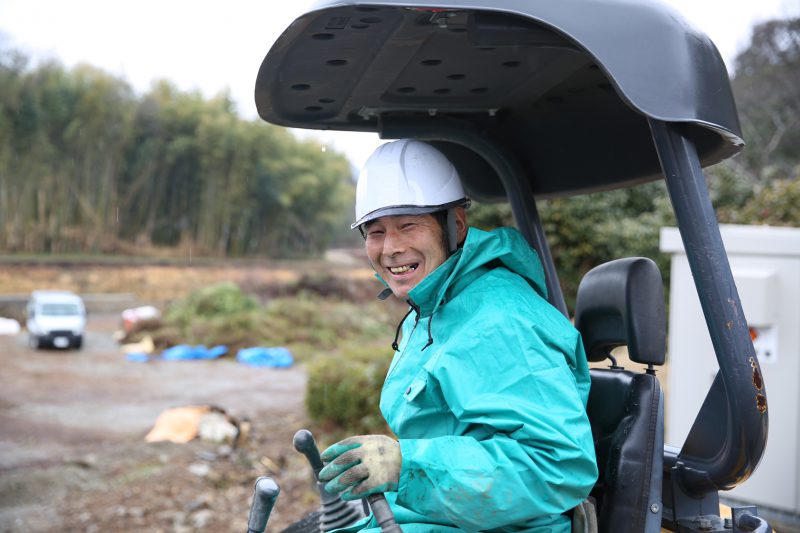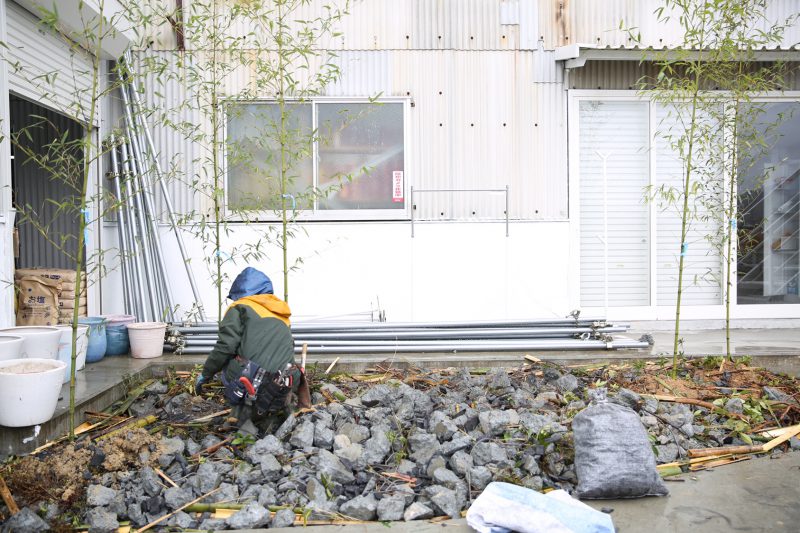niime 百科
Encyclopedia of niime
tamaki niime × 大地の再生講座
〈後編〉
tamaki niime × Earth Regeneration Lecture
〈 Part 2 〉
〈後編〉
〈 Part 2 〉

2019 . 03 . 01
「それが地球にとってベストであるなら、受け入れるしかない。」
地球という、自らもその一部である大きな生命体の基準に照らしながら、日々考え行動を心掛ける玉木は、同じく地球的視点で環境づくりの活動を進める「一般社団法人 大地の再生 結の杜づくり」代表の矢野智徳さんと出会い、彼にShop&Labの土地の再生を委ね、そのプランを丸ごと受け入れて、座学を聴き作業の様子を観ながら学んでゆくことにした。
― 今回「大地の再生」を実施するにあたって、玉木さんの方からこうしてほしいというディスカッションとか、意見のすり合わせとかは無かったわけですか?
玉木「完全に何も言わない。」
― お任せするというか。
玉木「元々、開けてみないと土地の状態が良いのか悪いのか、どれくらい酷いのか現状はわからないと聞いてて、じゃあそれはもう「現場主義」ですね、ってことで。現場で思ったとおりにしてもらって、よっぽどダメなら何か言うかもしれないけど、基本はもうお任せします、と。そう言ったはいいものの、何するかわかんないから、すごく???と思いながら観てたけど(笑)。…楽しかったね?」
酒井「うん。」
玉木「結局丸々6日くらいかかってやったんじゃないかな?」
― 予定の3日間で終わらずに作業が継続してましたね。お客様が来られるからとShopの玄関前は植栽まで先に終わらせて。
玉木「そこは早く済ませてほしいと。最終日の晩のギリギリまで皆さんやって帰ってた。2月末にはまたやるって決まって。」
tamaki niime における「大地の再生講座」には山梨を拠点とする矢野さんがこれまで全国的に講座を実施してきた中で、この講座で学び感銘を受け、それぞれの地域で大地の再生の実践活動をしているメンバーたちが主に西日本各地から参集している。
玉木「大地の再生講座をやるにあたって、この規模感でこれだけの“生徒”が一同に集まることってなかったんだって。だからチームとしてやることで、彼ら彼女らにとってもすごく学びの場になったし、もう少し小さな土地だと少人数でできてしまうから、皆んなでこんな風にひとつのものを創り上げるという、この一体感はないらしくて。今回はこのスタイルでやらせてもらって、自分たちもすごく良い学びになったと言ってて。良かったと思った。」
― 「大地の再生講座」としても新たな試みになったという。
玉木「備前の&BREADさんという「腹ごしらえ会」でウチに来てくれるパン屋さんがいるんですけど、今回の「大地の再生講座」の打合せに来てくれた岡山のメンバーの人が次の日に&BREADさんに遊びに行ったそうなの。で、昨日西脇に行ってねという話をしたら、えっ!西脇のどこですか!?みたいな。玉木さんとこって。普段別のところで繋がりがあった人たちが此処での大地の再生講座でもリンクして集まって来てるから、面白いなと思って。色んな人たちの化学反応が起こりつつあるなって。全然違うじゃない?「服づくり」と「土づくり」。楽しみだね。「人づくり」もあるけどね、今の私たちの課題は。」
― 服と食と土と。人がジャンルレスにコアな部分を共有しながら繋がってゆくみたいな。
酒井「なんか“地球のことを考えた現代アート”って気がするな、俺。」
― 「大地の再生」の活動そのものが。
酒井「はい。土や植栽の様子をマジマジと観ると、けっこうオモロイんです。ほんとヘンテコですよ、めっちゃ。あれはたぶん、地球のことを考えた現代アートです。」
玉木「矢野さんのやってることがね。」
酒井「矢野さんのバランスが。」
玉木「感性だしね、あの人はね。」
酒井「だから、僕はキャタピラの跡が付いたりだとか、コンクリート汚されると嫌で無茶指摘する人なんですけど、今回は珍しく言わなかったね。あれを現代アートとするなら、汚れもアートの一部と考えると、それもまた面白いなと。そういう意味で矢野さんの活動を通じて、こうゆう処はキレイでなければいけない!っていう今までの僕のひとつのエゴがとれたかなってゆう。まあそれはそれでいいやん、って思えるようになったってゆうか。」
玉木「それ、けっこう大きいことやね。」
酒井「むっちゃ大っきい。」
玉木「新しいコンクリートの上にタイヤの跡が付いたらキレるし、無茶潔癖症なのが、今回グッチャグチャにされたのに何も怒らないから。エゴがひとつとれて良かったなと。」
酒井「彼らの場合は、“きれいなもの”を創るってことが前提にあるやん。矢野さんの場合は、汚れも含めてすべてね、それも含めてパッケージされた彼のアートなんですよね。それを“柄”と考えるなら、すごく面白いバランスの。ほんとにね、色んな角度から、どう観たって面白いなってゆう。」
玉木「黒いパイプが顔を出してたり。」
酒井「矢野さんの持論では有機物も人工物も何もかも含めてすべてが地球のものやから、それを捨てる・捨てないの問題ではない、と。そこにあるものならそこの土地でしっかり消化させる、っていうのが彼の考えやから、それを聞いた時になるほどなって、それも腑に落ちたんですよ。僕は作業の様子を見て、なんと雑なと最初思ったけど、それも循環であり、何かしらの彼らのひとつの作品だとするなら、確かにそれもそれで面白いなぁと。」
玉木「ゴミ捨て場にゴミを捨てるって言うけど、地球ってゆうひとつの単体として考えた場合、「ゴミ箱」なんて無いじゃないですか?捨てる場所なんて。地球という生命体を人の身体のように考えてみたら。」
― なるほど…そうですね。
玉木「どこかに置いとく、保管する場所はあるかもしれないけど、それをゴミ箱と位置づけられる場所なんてあるわけないし、“ゴミ”を抹消させることも出来ないでしょ?」
― 自分の身体とか住む家とか「内」と「外」があったとして、地球全体を内と考えたら…
玉木「そう、でも外に捨てるってどこに捨てるの?じゃあ宇宙に持って行けばいいの?ってそうじゃないと思うし。矢野さんは震災のボランティアに行ってるそうで特に想いが強いようなんですけど、大多数の家屋が崩壊した時に皆んながゴミ捨て場に持って行ったら、ゴミ捨て場だらけになってしまうでしょう?阪神大震災で後片付けのボランティアとして現地に入った時に、矢野さんは訪れた敷地の大家さんに、僕はこれは全部ゴミじゃないと思うと言って。」
― はい。
玉木「だから、これを全部土に還して、それで浄化させていくということをやってみたい、その許可をくれませんか?とお願いしたそうなの。」
― …それはすごい話ですね。その段階ですでに「大地の再生」の活動を始めておられたんでしょうか?
玉木「それが最初で、きっかけだと言ってた。その時に大家さんはいいよと言ってくれて、今でもお付き合いが継続しているそうで。崩れた建物を全部土砂の中に混ぜ込みながら水脈を通す、同じように土に戻すという活動をして、それから毎年その土地を観に行って、定年変化を観察しながら、変な毒素が出てないか、ちゃんと循環出来てるかというのを調査に行ってるんだけど、今のところ全然問題無いし、このやり方でちゃんと循環出来るんだってゆうことを立証出来たから、僕にとってはそれが良いきっかけだったんだという事を仰ってて。捨てなくてもいけるんだとわかって、その考え方が今の活動の根本になっていると。」
― 震災がきっかけだったんですね。
玉木「だから、ウチの排水処理施設の大きなコンクリートの塊にしても、壊してゴミにするんじゃなくて、あれをどうやったら活かせるかを考えるべきだと言って下さったから、嬉しいと思って。楽しみなんです。」
酒井「そうやな。」
― 何か考え方というか…それこそ価値観が変わっちゃいますよね。
玉木「そうでしょ?」
― 捨てないという。
玉木「そうなの。“ゴミ”なんて存在しない、産み出した以上は。」
― 何かしらの意味がある。
玉木「一気にすべてをひっくるめて、ああそうだ!って感じになったんだよね、それで。」
酒井「うん。」
1月末の「大地の再生講座」で矢野さんとスタッフが「有機アスファルト」と呼ぶ、木屑とアスファルトを攪拌して混ぜ合わせたものをLabの入り口に帯状に敷設する様子を見学したことを思い出す。玉木と酒井から話を聞き、なぜ有機アスファルトなのかが腑に落ちた。有機物を加えることで、大地を塞いでいたアスファルトを捨てずに活かしながら使い、大地が呼吸出来るようにしているのだ。
2月26日からの3日間、再びtamaki niimeにおいて「大地の再生」講座が開催された。その初日、tabe roomでの座学を経てShop&Labの周囲の、前回の作業地を皆んなで観て回った。水脈を通し空気と水が循環し始めたことで地表に現れた小さな苔の綺麗な姿や土の団粒化など、変化の兆しを観察しながら矢野さんの説明を聞いた。その後は中高木が植栽されたり、Shop&Lab周りの新たな水脈づくりが進む。
隙間なくコンクリートやアスファルトに埋め尽くされ息が詰まっていた大地が開放され、木々の根がしなやかに伸びて行き水脈が張り巡らされ、人為的な境界に関係なく植物同士が繋がりあってゆく。そして空気と水の循環が生まれあらゆる生命にとって心地好い環境が広がってゆく。
ミクロとマクロ。tamaki niimeの拠点「日本のへそ」からスタートした「大地の再生」の取り組みが、大きな視点で見れば地球という生態系全体に繋がっていることに想い至り、快い興奮を覚えずにはいられなかった。長いこれからの年月の中で、豊かな植生に囲まれtamaki niimeのShop&Labがどんな変化を見せてゆくのか、その成長と移ろい行く表情をも楽しみにしたいと思う。
書き人越川誠司
“If it is the best for the earth, then we must accept it.”
Ms Tamaki, who considers the standards of the Earth, a vast living organism of which she is part, met with Mr Tomonori Yano, the Earth Restoration representative, an association that promotes global environmental activities.
Did you have any discussions about what you wanted the project to be like, or were there any differences of opinion to carry out the Earth Regeneration project?
- Tamaki
- I didn’t say anything at all.
—— You left it up to them.
- Tamaki
- Originally, I heard that you couldn’t tell whether the land was in good or bad condition or how bad it is until you dig it up. I said, “I’ll let you do what you think at the site, and if it’s not good enough, I might say something, but basically, I’ll leave it to you. I said that, but I didn’t know what they would do. (laugh) …it was fun, right?
- Sakai
- Yes.
- Tamaki
- Eventually, it took us about six whole days to do it, didn’t it?
—— It didn’t finish after three days and continued. You had to finish the planting in front of the entrance to the shop before the guests arrived.
- Tamaki
- We wanted them to finish that as soon as possible. They did their best on the final day, and they went home. We decided to complete it at the end of February.
Mr Yano, based in Yamanashi, has been conducting the “Earth Regeneration Lecture” at tamaki niime and throughout the country. The lecture members were inspired and practised earth regeneration in their regions, mainly from western Japan.
- Tamaki
- When they held the Earth Regeneration Lecture, they had never had so many “students” gather together on this scale. It would have been done in a smaller area by a smaller number of people, so they wouldn’t have had this sense of unity to create something together. They said that they learned a lot from doing it in this style. I’m glad we did it.
—— It was also a new attempt for the Earth Regeneration Lecture.
- Tamaki
- There’s a bakery in Bizen called &BREAD that comes here for the “Hara-goshirae-kai”, and one of the members from Okayama went to the meeting for this Earth Regeneration Lecture went to visit &BREAD the next day. When I told him that I had been to Nishiwaki previously, he said, “What? Where in Nishiwaki?” I was like, “Where in Nishiwaki?” He said he was with Tamaki-san. I thought it was interesting that people who usually have connections elsewhere were linked and came together for the Earth Revival Lecture. I thought it was interesting. I felt that a chemical reaction was occurring among many different people. It’s completely different. I was making clothes and making soil. I’m looking forward to it. We also have to create for people, which is what we’re working on now.
—— Clothes, food, and soil. It’s like a genre-less way to connect people while sharing the core.
- Sakai
- I feel like it’s a kind of contemporary art that considers the earth.
—— The activities of the Earth Regeneration itself.
- Sakai
- Yes. If you look at the soil and the plants, it’s pretty interesting. It’s peculiar, and it’s really weird. It’s probably modern art with the earth in mind.
- Tamaki
- What Mr Yano is doing…
- Sakai
- His balance.
- Tamaki
- It’s his sensitivity, you know.
- Sakai
- I usually don’t like the marks when the caterpillar runs and the concrete gets dirty, and I’m the kind of person who points out outrageous things, but this time, I didn’t say anything, which is unusual. If you consider that to be modern art, it’s interesting to think of the dirt as part of the art. In that sense, through Mr Yano’s activities, one of the things I’ve been thinking about is that such places should be clean! Through his activities, I think my ego that such areas must be clean has been taken away. I’ve come to think, “Well, that’s okay.”
- Tamaki
- That’s a pretty big deal.
- Sakai
- It’s huge.
- Tamaki
- He usually gets mad when he sees tire marks on new concrete, and he is an absurdly meticulous person, but this time He didn’t get angry about it being messed up. I’m glad that one of his issues was removed.
- Sakai
- In the usual cases, the premise is to create beautiful things. In the case of Mr Yano, everything, including the dirt, is packaged as his art, isn’t it? If you think of it as a “pattern,” it’s a fascinating balance. It’s exciting, no matter how you look at it from various angles.
- Tamaki
- There’s a black pipe peeking out.
- Sakai
- Mr Yano’s theory is that everything, organic and artificial, belongs to the earth, so it’s not a matter of throwing it away or not. His idea is that if it should be digested in the land, it made sense to me if it’s there, when I heard that. When I saw the work, I thought it was a bit messy at first, but if it’s also a cycle, and if it’s one of their works, then it’s certainly interesting.
- Tamaki
- People say that we throw garbage in the garbage dump, but if you think of the earth as a single unit, there is no such thing as a garbage can, isn’t there? There is no place to throw away. Think of the Earth as a living organism, like a human body.
—— I see… that’s right.
- Tamaki
- There may be a place to keep it, to store it, but there is no place where it can be positioned as a trash can, and you can’t erase “trash,” can you?
—— If there is an ‘inside’ and an ‘outside’, such as your body and the house you live in, and if you think of the whole earth as inside…
- Tamaki
- Yes, but where do you dump it outside? Then, should I take it to space? I don’t think so. I heard that Mr Yano has been volunteering for earthquake and tsunami relief efforts, and he seems to have strong feelings about it. After the Great Hanshin Earthquake, he was there as a volunteer cleaning up. And he told the landlord of the property he visited that he didn’t think it was all garbage.
—— Yes.
- Tamaki
- So, he would like to return all of it to the soil and purify it. He asked if the landlord could permit him to do that.
—— … That’s a fantastic story. Did you already start the Earth Regeneration activities at that stage?
- Tamaki
- That was the first time, and he said it was the trigger. The landlord said it was a good idea at that time, and they are continuing their relationship. Since then, he has been going to see the land every year, observing the changes over time, to see if there are any strange toxins and if the circulation is working properly. So far, there is no problem at all, and I proved that this method could circulate adequately, so that was an excellent opportunity for him. That’s what he said. Because he confirmed that it was possible to recycle in this way, he said that he realized that he didn’t have to throw anything away and that this way of thinking became the basis of his current activities.
—— So the earthquake was the trigger.
- Tamaki
- That’s why I was so happy when he said that we should think about how we can make use of the large lump of concrete in our wastewater treatment facility instead of just destroying it and throwing it away. I’m looking forward to it.
- Sakai
- I guess so.
—— It’s something about the way you think…it changes your sense of value.
- Tamaki
- Isn’t that right?
—— You don’t throw things away.
- Tamaki
- That’s right. There is no such thing as ‘garbage’ as long as it is produced.
—— It has some meaning.
- Tamaki
- It all came together at once, and I was like, ‘Oh yeah! That’s how I felt.’
- Sakai
- Yeah.
I remember observing Mr Yano and the staff laying a strip of organic asphalt, a mixture of wood chips and asphalt, at the Lab entrance during the Earth Regeneration Lecture at the end of January. After listening to Ms Tamaki and Mr Sakai, it became clear why organic asphalt is so essential. Adding organic matter to the asphalt, which had been blocking the earth, is now being used instead of being thrown away so that the planet can breathe.
For three days from February 26, the “Earth Regeneration Lecture” was held again at tamaki niime. On the first day of the course, after the classroom lecture in the tabe room, we all went to see the previous work site around the Shop & Lab. We listened to Mr Yano’s explanation while observing the signs of change, such as the beautiful appearance of tiny mosses on the surface of the ground and the granulation of the soil as air and water began to circulate through the water veins. After that, medium to tall trees were planted, and the creation of a new water vein around the Shop & Lab proceeded.
The earth, which had been choked with concrete and asphalt, was opened up, and the roots of the trees grew supple, creating a water vein, and plants connected regardless of artificial boundaries. And the circulation of air and water is born, creating a comfortable environment for all life.
Micro and macro: I couldn’t help but be pleasantly excited when I realized that the Earth Regeneration project that started from the Navel of Japan, the base of tamaki niime, is connected to the earth’s entire ecosystem, a larger perspective. I’m looking forward to seeing how the shop and lab of tamaki niime will grow and change over the long years to come, surrounded by rich vegetation.
Original Japanese text by Seiji Koshikawa.
English translation by Adam & Michiko Whipple.


